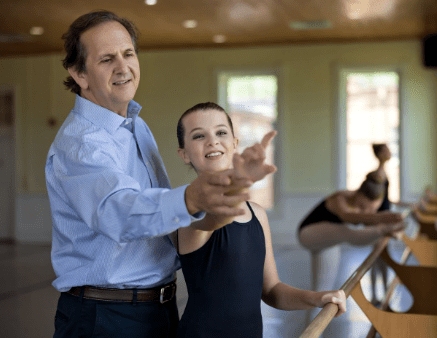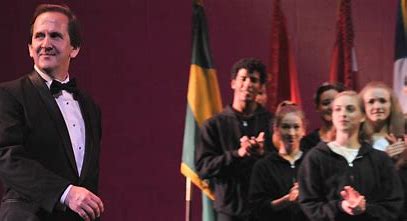
(Photo: Robby Followell Photography
- Ballet Mississippi’s artistic director is the heart and soul of the company. He’s had ballet in his blood since he was six years old.
David Keary, artistic director of Ballet Mississippi, did not set out to be a legend, but he is undoubtedly on the path to becoming one. The recipient of the 2018 Governor’s Arts Award for leadership in the performing arts, David’s pursuit of his life-long passion for dance has enriched the lives of thousands right here in Mississippi.
In 1994, when the financially troubled Ballet Mississippi suspended its professional company, totaled its $150,000 debt, and wondered what to do next, the board turned to then-attorney David Keary.
A new board member at the time, David was a barely semi-retired professional dancer, a recent graduate of Jackson School of Law, and clerk for Mississippi Supreme Court Justice James W. Smith. He spent his teen years and twenties dancing with the New York City Ballet and the Fort Worth Ballet and studied under greats like George Balanchine, Thalia Mara, Albia Kavan, and Rex Cooper.
This year, David Keary, as artistic director, celebrates a thirty-year milestone with the premiere performing arts organization. He has had ballet in his blood since he was six years old.
As a child, he was athletic and agile, but he was small in size. He also had a musical ear. When he discovered Fred Astaire and Gene Kelly movies, he was fascinated with the moves, the footwork, and the way they made something so hard look easy.
David wanted to take dancing lessons but did not want his side hobby to become public knowledge among his friends. It was the 1960’s. Male dancers were unheard of in the Deep South. His musical father, who had been quite a virtuoso clarinetist and tenor saxophonist in the years after WWII, was wise enough to let David give dance a try. Father even covered for son when one of his neighborhood buddies came to the door on a dance afternoon to ask if David could join a game of baseball, football, or something else the neighborhood gang had instigated. David might hide behind the door in his dance clothes, but his dad would tell the friend, “David has to go downtown with me on an errand right now. Maybe next time!”
He was twelve when the Jackson Ballet School invited world-renowned dancer and choreographer Edward Villela and ballerina Gelsey Kirkland to perform. David was mesmerized by the brilliant pair as Villela lifted his partner into the air, carrying her back and forth across the stage as though she were a feather. They danced with a grace he had seen only in the movies, and David saw strength, athleticism, and art. He immediately told his father, “That is what I want to do.”

David enrolled at the Jackson Ballet as an eighth grader, the lone male dancer. When the Clarion Ledger ran an article on the dance company, including a school picture identifying David by name, his secret was out. There was a little ribbing, but not enough to make him change his mind. He would become a dancer.
As a 15-year-old, David earned a scholarship to a summer program at the School of American Ballet in New York City.
David says, “It took a lot of convincing, but my parents finally gave the okay.” Even amidst the best of the best from all over the country, he did not flinch or lose his enthusiasm. He returned the following summer for more grueling instruction.
Back home at the Jackson Ballet, he studied with Thalia Mara, the iconic American ballerina, teacher, writer, educator, historian, and founder of the International Ballet Competition. She was tough and demanding, but David was determined to exceed her expectations.
Graduating from Woodland Hills Baptist Academy in 1976, he enrolled at the University of Southern Mississippi planning to study journalism. Even today, he is not sure why except that he had friends heading to Hattiesburg for college.
When he came home for a ballet lesson after the first week of school, Thalia Mara looked him in the eye and said, “David, you’ve got to decide what you want to do in life. If you don’t want to do this, do something else. But if you do want to do this, get yourself in here. Commit and do this.”
Her words were prophetic. David sat in his bedroom for the next 24 hours, Thalia’s words ringing in his ears. Late on Sunday afternoon, when he should have been packing his car to head back to school, he told his parents, “I can’t do this. I am a dancer. I have to dance.”

For the next year, he threw all his energy into dance study. Thalia Mara appointed him, along with Kathy Thibodeaux, as the first paid professional with the Jackson Ballet Professional Company. In 1978, he returned to New York, dancing with the NYC Ballet for the next five years.
In 1985 the Fort Worth Ballet called, inviting him to dance as a principal on leave from the New York City Ballet. There, in addition to dancing through an extensive repertoire center stage, he learned a few skills that would be enormous in his future. Teaching and running the financial side of a ballet company were part of a unique learning curve in Texas.
Returning to Jackson in 1988, David was approaching his thirtieth birthday. His body was hurting from the decades of training. He thought his dancing career might be drawing to a close, so he enrolled at Millsaps, completing his undergraduate degree before entering the Jackson School of Law. He finished law school in December 1993, just in time to witness the financial emergency threatening Ballet Mississippi with bankruptcy.
In short order, the anxious Board of Directors convened and appealed to David Keary’s loyalties, affections, and passion. He was the one individual who had the skill set to take on the immediate crisis.
Although Ballet Mississippi’s professional arm was not to be saved then, David’s know-how has resulted in rebuilding an acclaimed school while strategizing for continuous growth and improvement and eventually another professional company.
In the meantime, David, while watching the bank account, is able to bring in professional artists each year for workshops and special events. He can whet the appetite of his most gifted students to aspire to greater goals than a local company.
With a downtown studio and a larger studio space in Madison, today’s school offers classes in classical ballet, jazz, tap, modern dance, and soon-to-come ballroom dancing. Four instructors with impressive credentials teach around 300 students. From age three to 83, aspiring dancers of diverse skill levels find their place.
David choreographed Ballet Mississippi’s version of The Nutcracker in 1995, his first year as artistic director. It is now a Christmas tradition. He enjoys “tweaking” his masterpiece ever so slightly each year and invites former students to participate.
Some who first danced as children dance today as parents in the party scene. Claire Green Ridgway is one of those. Now the mother of three teenage boys, she began ballet lessons as a four-year-old and was a devastated 12-year-old when the first Ballet Mississippi temporarily closed its doors. She calls David Keary the “bright light” who brought ballet back to her life. David is more than a mentor and a teacher. Like most of his students, Claire considers David her lifelong friend.
Life is not entirely ballet to David. The man of many talents is also an accomplished jazz guitarist who has performed as a “Swing de Paris” member for 17 years. Having studied with Woody Mann, renowned American jazz and blues guitarist, and Pete Hutlinger, John Denver’s lead guitarist, David, along with fellow musicians, often performs in local venues. Drop by Table 100 for a Sunday brunch and enjoy David’s guitar as part of a group with Raphael Semmes and other local talents.
David is 65 and as energized by his craft as fifty-plus years ago. His future plans include a $2.4 million capital campaign for the ballet’s new arts center and expansion of programming and faculty. Just hearing him talk makes me wish I could dance!
He reminds me, “Arts are paramount to a vibrant community.”
Yes. True. And a vision every one of us should support.











